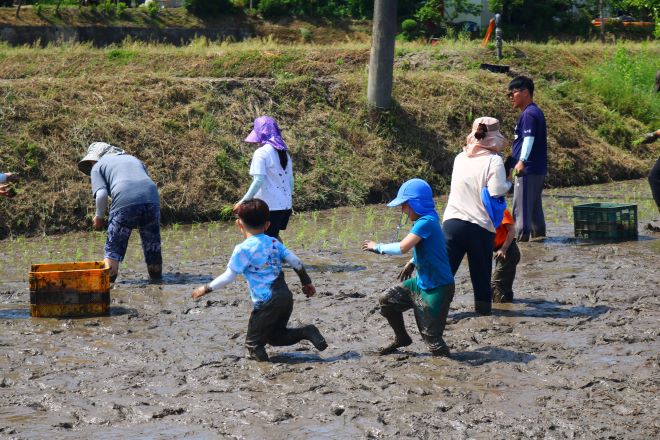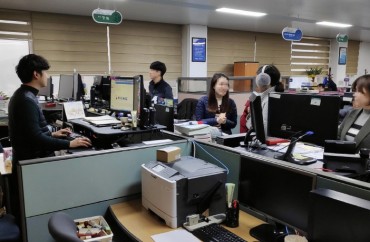
As the workforce in rural areas dwindles, there’s a burgeoning rise in programs aimed at connecting individuals with the authentic essence of rural life. Featured here is a snapshot of one such initiative, a rural experience program. (Image courtesy of Yonhap)
SEOUL, Apr. 19 (Korea Bizwire) – Faced with a stark decline in birth rates and an aging population exacerbated by an exodus to cities like Seoul, rural towns across South Korea are scrambling to reverse the trend of dwindling populations with a raft of creative policies aimed at luring new residents.
The strategies broadly fall into three main categories: improving living conditions, bolstering child care and education, and attracting commuters and visitors to offset the loss of permanent residents.
With total population numbers serving as both a symbolic metric and policy compass for local governments, some authorities are rolling out audacious initiatives to buoy their head counts.
In Goseong County, South Gyeongsang Province, officials had set their sights on maintaining a population of 50,000, a critical threshold for determining policy and budget allocations.
But after briefly surpassing that milestone, the county has struggled to regain the 50,000 mark. It has now formed a special youth population task force to devise measures for increasing residency and attracting new businesses.
Other municipalities like Geochang County in South Gyeongsang and Jeongeup in North Jeolla Province have made maintaining populations of 60,000 and 100,000, respectively, their top priorities for 2024.
Jeongeup aims to preserve a permanent population of 100,000 while increasing its daily influx by 10 percent and its youth population to 20,000.

Numerous initiatives are underway to breathe new life into rural economies, with Gyeongsangnam-do’s recent announcement selecting Namhae and Geochang counties for the 2024 Rural CreaTour Support Project. The ‘CreaTour’ program epitomizes creative tourism, empowering local residents to design and manage tourism offerings leveraging indigenous resources in collaboration with private travel agencies. The accompanying image captures the serene beauty of the Namhae Sea. (Image courtesy of Gyeongnam Province)
Seocheon County in South Chungcheong Province even held a rally last October with 200 officials vowing all-out efforts to reclaim a population of 50,000, including a campaign encouraging public employees living elsewhere to relocate their official residences.
The city of Incheon is instituting its boldest birthrate policy yet — promising 100 million won in total aid to every child born in the city until age 18, dubbing it the “100 Million Plus Dream” program.
As a first step, the city began offering 500,000 won in transportation subsidies to expectant mothers this month.
Overall, Incheon plans to spend 618 billion won on population policies this year, with another 149 billion won dedicated to areas suffering population declines.
South Chungcheong Province is taking a novel approach by mandating that provincial employees with children under 2 years old work remotely one day per week — a first for South Korea’s public sector aimed at easing the burdens of juggling work and child-rearing.
For regions where declining industries have driven population shortfalls, the urgency is even greater. The industrial city of Ulsan reached its peak population of 1.2 million in 2015, but then saw an exodus as its key shipbuilding sector contracted, prompting many young workers to leave in search of jobs elsewhere.
Ulsan’s total population has since dwindled to around 1.13 million as of February. In response, city officials have made corporate investment and job creation their top priority to stem the outflow, pushing policies to attract businesses with measures like on-site government facilitators for major investments and appointments of private sector executives to municipal leadership roles.
The idea is that an influx of quality jobs will draw young job-seekers back and allow Ulsan to convert them into permanent residents.
Other cities facing acute population declines are looking abroad. Busan aims to host 30,000 international students by 2028 while raising its proportion of foreign engineering and science students to 30 percent and boosting the rate who transition to local jobs and residency visas to 40 percent.
Meanwhile, South Gyeongsang Province is leveraging a special visa program that incentivizes foreign residents, including international students and ethnic Koreans, to settle in localities suffering depopulation by offering long-term residency for those who find jobs or start businesses there.
A recent Statistics Korea projection forecasts the proportion of foreigners in the national population could reach as high as 6.9 percent by 2042, suggesting immigration will likely play a key role in tackling South Korea’s demographic crisis.
Some pockets have managed to turn the tide. Daegu’s Jung District, for instance, achieved the nation’s highest population influx rate in 2022, pushing past 90,000 residents after years of urban blight triggered an exodus. Its rebound followed concentrated efforts at downtown rejuvenation projects alongside expanded childcare facilities and job programs for seniors.
M. H. Lee (mhlee@koreabizwire.com)






